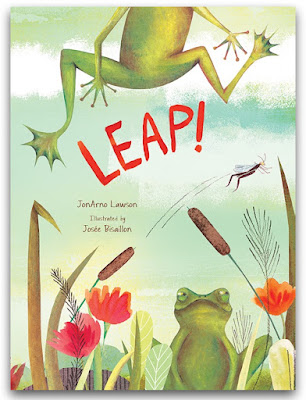Written by Ted Staunton and Will Staunton
Illustrated by Bill Slavin
Formac Lorimer
978-1-459504974
96 pp.
Ages 5-8
September 2017
Being scared is normal. Still, being seen as being scared and labelled a chicken or a scaredy-cat is something all children and many adults would avoid at all costs. That's Morgan's dilemma. He and everyone from his class have been invited to new kid Curtis's birthday party at which the boy plans to show the horror movie Brain Eater. Worse, the rumours about the movie elevate the scariness factor.
Worse, his frenemy Aldeen (she's the tall one with the witchy hair in Bill Slavin's illustration above) says that scary movies are boring and she's seen a million of them. So he gives one a try. He watches The Wizard of Oz in the safety of his home with his parents and he still freaks out, closing his eyes. Is there a way to go to Curtis's party and watch that movie and not lose face?
Somehow father and son authors Ted Staunton and Will Staunton get into the head of the freakishly normal Morgan, knowing how natural fears can escalate to horrific proportions with the right inputs from peers and an active imagination. Because the scenario in which Morgan the Brave finds himself is so commonplace, the story becomes familiar and funny and clever. Though cautionary tales are generally more folkloric, Morgan the Brave is still a lesson-learning story that worries can exacerbate fears and that the anticipation is usually far worse than the reality.
Parents, you can reassure your children with a reading of Morgan the Brave while teachers can do the same with their early readers who would probably be more accepting of the premise that they shouldn't give into their fears if they read it for themselves. At a Reading Level of 2.2. (i.e., that of a child in the second month of Grade 2) and accompanied by Bill Slavin's comical art, it's not an intimidating read at all.
😱😱😱
 |
From Morgan the Brave
by Ted Staunton and Will Staunton
illus. by Bill Slavin
|
"I heard they use real earwax," whispers Charlie.
"My brother watched it," says Matt, "and he passed out!"
Melissa hisses, "Did you hear what they make the spaghetti out of?" (pg. 11)
Worse, his frenemy Aldeen (she's the tall one with the witchy hair in Bill Slavin's illustration above) says that scary movies are boring and she's seen a million of them. So he gives one a try. He watches The Wizard of Oz in the safety of his home with his parents and he still freaks out, closing his eyes. Is there a way to go to Curtis's party and watch that movie and not lose face?
Somehow father and son authors Ted Staunton and Will Staunton get into the head of the freakishly normal Morgan, knowing how natural fears can escalate to horrific proportions with the right inputs from peers and an active imagination. Because the scenario in which Morgan the Brave finds himself is so commonplace, the story becomes familiar and funny and clever. Though cautionary tales are generally more folkloric, Morgan the Brave is still a lesson-learning story that worries can exacerbate fears and that the anticipation is usually far worse than the reality.
Parents, you can reassure your children with a reading of Morgan the Brave while teachers can do the same with their early readers who would probably be more accepting of the premise that they shouldn't give into their fears if they read it for themselves. At a Reading Level of 2.2. (i.e., that of a child in the second month of Grade 2) and accompanied by Bill Slavin's comical art, it's not an intimidating read at all.
😱😱😱
Like Ted Staunton's original Morgan series, Morgan the Brave would be a great addition to the listing of #CanLitChoices for Grade 2 novel studies that I prepared almost exactly two years ago. Check out those titles here.









































